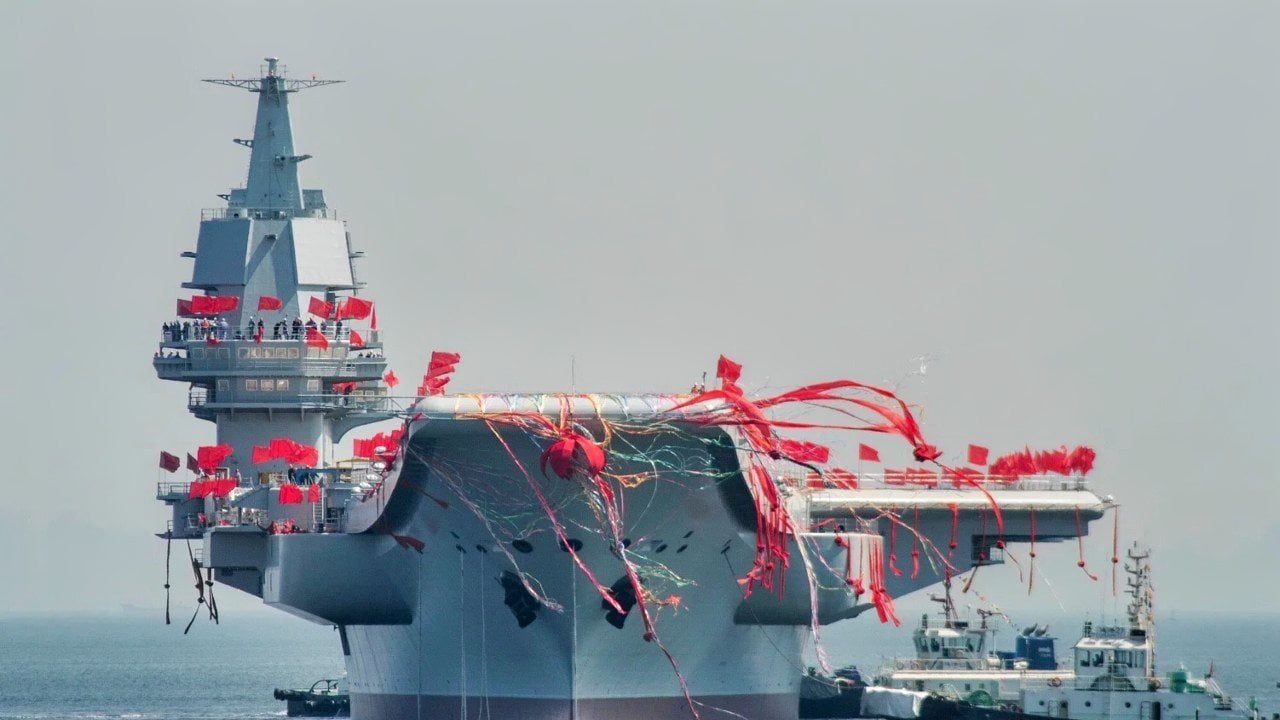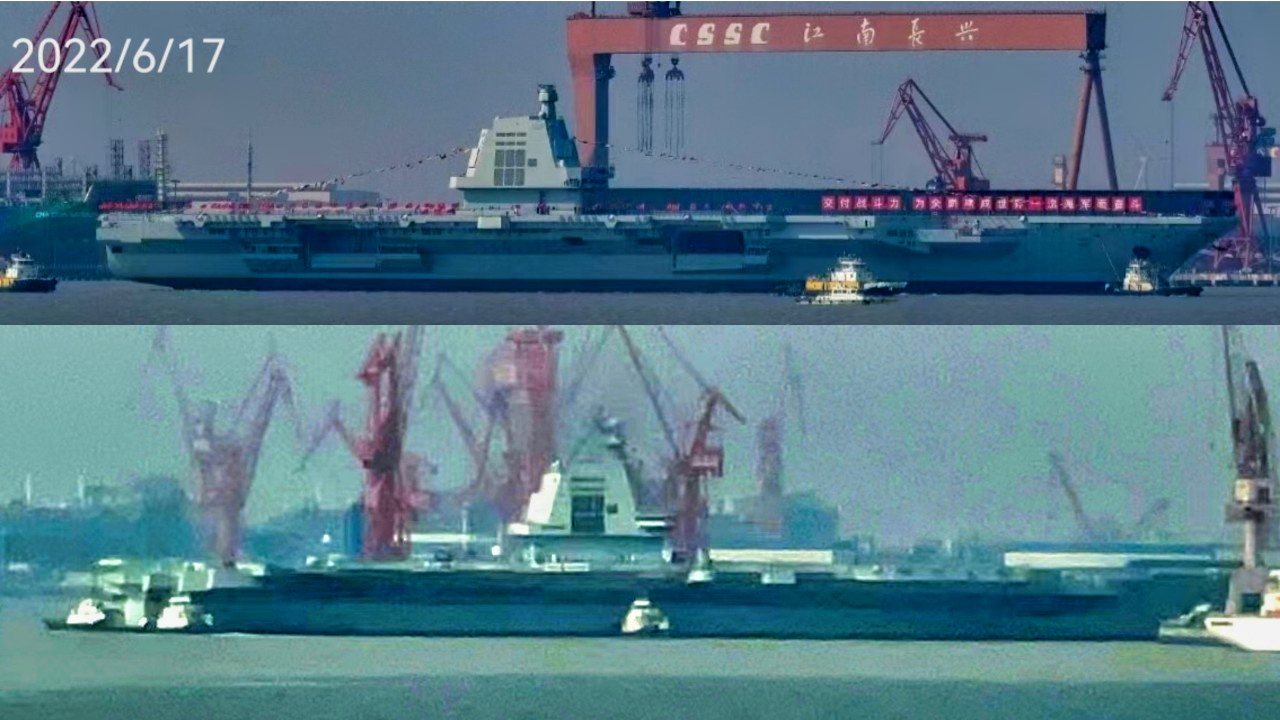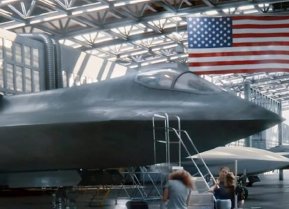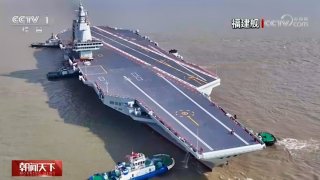China Says New Aircraft Carrier Is 'Largest Conventionally Powered Warship'
The Chinese People's Liberation Army Navy's newest aircraft carrier, the Type 003 Fujian, has been praised as the "world's largest conventionally powered warship" by Chinese state broadcaster CCTV.
Summary and Key Points: The Chinese People's Liberation Army Navy's newest aircraft carrier, the Type 003 Fujian, has been praised as the "world's largest conventionally powered warship" by Chinese state broadcaster CCTV.

-Despite not being nuclear-powered, the Fujian boasts advanced electromagnetic catapult technology, enabling it to launch larger and more heavily armed aircraft, including AEW&C planes like the KJ-600.
-This marks a significant leap in China's carrier capabilities. China's naval ambitions, driven by a desire to rectify historical humiliations, have evolved significantly from studying acquired foreign carriers to developing formidable indigenous warships.
China's Type 003 Fujian: A Game-Changer in Aircraft Carrier Technology
Chinese state-owned broadcaster CCTV praised the People's Liberation Army Navy's (PLAN’s) newest aircraft carrier, the Type 003 Fujian, describing it as the "world's largest conventionally powered warship." CCTV further suggested that, "In a sense, the larger the carrier's displacement, the greater its combat power."
Though Beijing hasn't offered official figures on the warship's size, the Type 003 Fujian is reported to displace 80,000 tons. As Interesting Engineer suggested, that is on par with the U.S. Navy's decommissioned Kitty Hawk -class conventionally powered supercarriers.
The warship would thus have a smaller displacement than the U.S. Navy's Nimitz-class or Gerald R. Ford-class nuclear-powered carriers, which have a full-load displacement exceeding 100,000 tons.
China's New Aircraft Carrier: Not-Nuclear – But Still Capable
CCTV was quick to emphasize that even as Fujian isn't a nuclear-powered aircraft carrier, it is still equipped with advanced technology – notably its catapults.
"The arrival of the Fujian has not only debunked, with its strength, the design theory that only nuclear-powered carriers can use electromagnetic catapults, but also elevated the combat capabilities of future domestically made carriers to another level," the CCTV report added.
The warship's advanced launch and recovery system makes it fit to operate with larger and heavier aircraft. The PLAN's first two carriers – the Type 001 Liaoning and Type 002 Shandong – both employ ski-jump ramps at the front of the flight deck to launch aircraft. More heavily armed multirole fighters can operate from the Type 003, but as importantly, the vessel will be able to carry other aircraft that will enhance its capabilities.
"While China's older ski-jump carriers must rely on helicopters with small, rotating radars or land-based aircraft for airborne early warning and control, Fujian will be able to launch larger AEW&C aircraft like the KJ-600, an aircraft similar to the U.S. Navy’s E-2D Hawkeye,” Defense One reported earlier this month. “The ability to launch the KJ-600 will revolutionize China’s carrier operations, allowing the task group to operate independently, farther from Chinese territory with a powerful airborne radar high overhead offering comprehensive battlespace awareness for hours at a time."
Erases Century of Humiliation
As Defense One further noted, Beijing's carriers and blue-water navy ambitions were meant to correct the wrongs of China's "Century of Humiliation," which began with the First Opium War (1839-1842) and ended in the late 1940s, after a bloody civil war, with the establishment of the People's Republic of China.
China's Qing Dynasty-era defeat at the Battle of the Yalu River in 1894, during the First Sino-Japanese War, also underscored the importance of naval power.
The Great Leap Forward in Navy Design
China’s carrier ambitions go back as far as 1949, but funding was long absent, as was access to the necessary technology.
The first true opportunity came in 1985 when Beijing bought the ex-Australian HMAS Melbourne (R21), a Majestic-class light aircraft carrier that was operated by the Royal Australian Navy (RAN) from 1955 until 1982. It was the third and final conventional carrier used by the RAN.
Laid down as HMS Majestic during World War II, she was launched in 1945 and was only nearing completion when the war ended. Work progressed slowly, but many lessons related to carrier design and operation learned during the war were incorporated into the ship's modernization. Designed as a somewhat "disposable warship" that would likely be retired after the war ended, the carrier instead went on to serve with the RAN for decades.
Her lengthy service was followed by time spent in a mothballed state, after which the ship was officially retired and sold for scrap to China for $1.4 billion. When the ship arrived in China in 1985 for scrapping, engineers studied the flattop in detail. The ship was antiquated by that time, and the Australians had removed any modern and sensitive technology, but Chinese engineers reportedly showed special interest in equipment such as Melbourne's catapults, arrestor wires, and aircraft lifts.

The flight deck was dismantled and put ashore, where PLAN pilots used it for landing practice. It was copied, and a replica was used to launch aircraft. Much of the carrier remained in existence until at least as late as 1994, and it gave Beijing valuable insight into carrier operations. The scrapping efforts only began in earnest in 1994 and took several more years to complete.
Even during scrapping, it appears that every crucial part was studied before being melted down. Not surprisingly,the PLAN claimed it was just taking advantage of the opportunity to study a ship that had already been bought. In reality, it probably sought to acquire the carrier for study from the beginning.
In the early 2000s, China then acquired the former Soviet Navy Project 11435 Kuznetsov-class heavy aircraft-carrying cruiser Varyag. This was later refurbished as the Type 001 Liaoning, truly jump-starting China's carrier program.
Author Experience and Expertise: Peter Suciu
Peter Suciu is a Michigan-based writer. He has contributed to more than four dozen magazines, newspapers, and websites with over 3,200 published pieces over a twenty-year career in journalism. He regularly writes about military hardware, firearms history, cybersecurity, politics, and international affairs. Peter is also a Contributing Writer for Forbes and Clearance Jobs. You can follow him on Twitter: @PeterSuciu. You can email the author: [email protected].
All images are Creative Commons or Shutterstock.
From the Vault
Russia Freaked Out: Why the U.S. Navy 'Unretired' the Iowa-Class Battleships
Battleship vs. Battlecruiser: Iowa-Class vs. Russia's Kirov-Class (Who Wins?)


